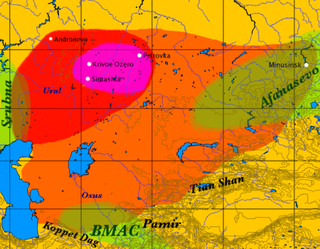This is an old revision of this page, as edited by Dbachmann (talk | contribs) at 17:30, 16 August 2005. The present address (URL) is a permanent link to this revision, which may differ significantly from the current revision.
Revision as of 17:30, 16 August 2005 by Dbachmann (talk | contribs)(diff) ← Previous revision | Latest revision (diff) | Newer revision → (diff)
The Andronovo culture is a cover term for a group of Bronze Age culturess of southern Siberia and Central Asia, ca. 2300 BC–1000 BC. The name derives from the village of Andronovo (55°53′N 55°42′E / 55.883°N 55.700°E / 55.883; 55.700), where in 1914, several graves were discovered, with skeletons in crouched positions, buried with richly decorated pottery.
At least four sub-cultures are distinguished, during which the culture expands towards the south and the east:
- Sintashta-Petrovka (Southern Urals, northern Kazakhstan, 2300-1600 BC), after the Sintashta fortification of ca. 1800 BC at the upper Ural (Chelyabinsk province)
- Alakul (2100-1400 BC)
- Fedorovo (1400-1200 BC)
- Alekseyevka (1200-1000 BC)
In southern Siberia and Kazakhstan, the Andronovo culture was succeeded by the Karasuk culture.
The geographical extent of the culture is vast, and difficult to delineate exactly. On its western fringes, it overlaps with the approximately contemporaneous Srubna culture in the Volga-Ural interfluvial, to the east it reaches into the Minusinsk depression, overlapping with the area of the earlier Afanasevo culture, and sites are scattered as far south as the Koppet Dag (Turkmenistan), the Pamir (Tajikistan) and the Tian Shan (Kyrgyzstan). The northern boundary vaguely corresponds to the beginning Taiga.
They mined deposits of copper ore in the Altai Mountains and lived in villages of as many as ten sunken log cabin houses measuring up to 30m by 60m in size. Burials were made in stone cists or stone enclosures with buried timber chambers.
In other regards, the economy was pastoral, based on horses and cattle, but also sheep and goats.
The Andronovo culture has been strongly associated with early Indo-Iranian culture. In particular, it is credited with the invention of the spoke-wheeled chariot around 2000 BC; Di Cosmo (p. 903) referring to finds related to the Andronovo culture from "as early as 2026 B.C."
Sintashta is a site on the upper Ural River. It is famed for its grave-offerings, particularly chariot burials. These inhumations were in kurgans and included all or parts of animals (horse and dog) deposited into the barrow Sintashta is often pointed to as the premier proto-Indo-Iranian site, and that the language spoken was still in the Proto-Indo-Iranian stage. There are similar sites "in the Volga-Ural steppe" (Mallory).
In the northeast, its successor was the Karasuk culture (1500-800 BC), which is sometimes asserted to be non-Indo-European, and at other times to be specifically proto-Iranian.
References
- "The Northern Frontier in Pre-Imperial China", Cambridge History of Ancient China (pp. 885-966) ch. 13, Nicolo Di Cosmo.
- James P. Mallory, "Andronovo Culture", Encyclopedia of Indo-European Culture, Fitzroy Dearborn, 1997.